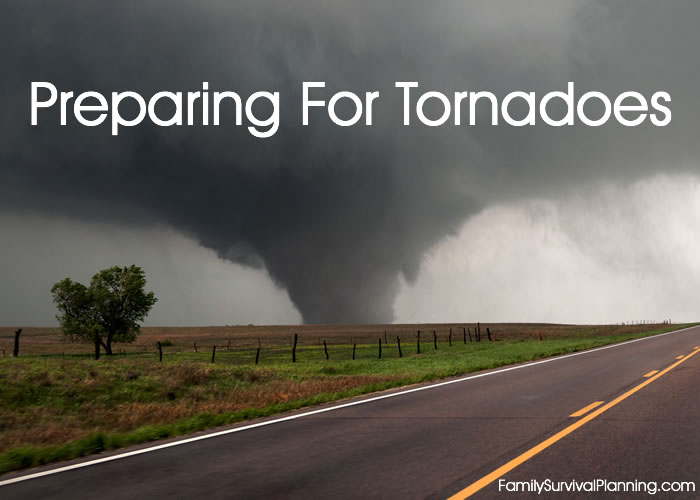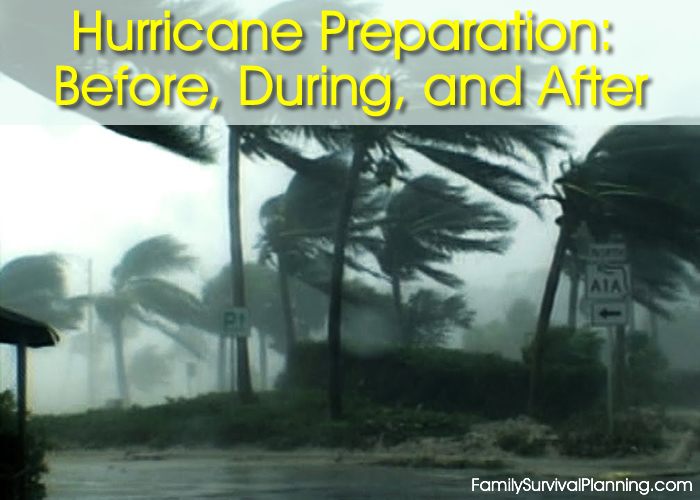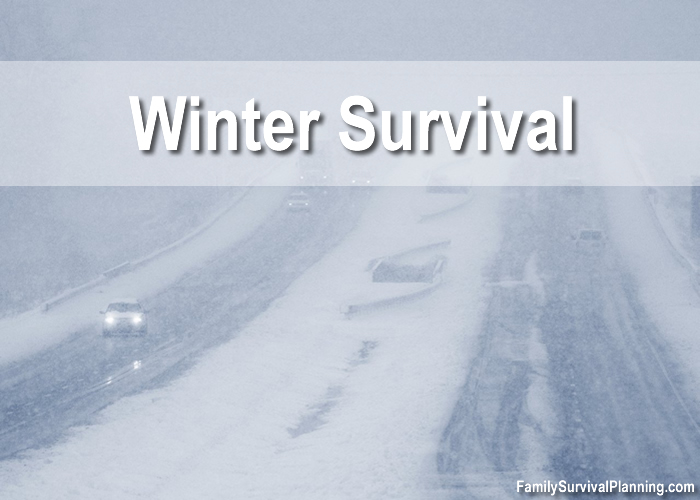
- HOME
- Natural Disaster Survival
- Tornado Preparation
Know What To Do Before, During and After a Tornado

Tornado preparation is imperative if you live in an area where they are common or frequent.
Tornados may strike quickly, with little or no warning. They may appear nearly transparent until dust and debris are picked up or a cloud forms in a funnel.
The average tornado moves southwest to northeast, but tornados have been known to move in any direction. The average forward speed is 30 miles per hour but may vary from stationary to 70 miles per hours, with rotating winds that can reach 300 miles per hour.
Tornados are most frequently reported east of the Rocky Mountains during spring and summer months but they can occur in any state at any time of year. No hard and fast rules here - so preparation is the only solution.
In the southern states, peak tornado season is March through May, while peak months in the northern states are during the late spring and early summer. So if you are a resident in any of these areas, here's what you can do to prepare.
Invest in emergency food storage now and enjoy peace of mind for the next 25 years. Don't miss out on the savings!
What To Do Before Tornadoes Threaten
1. Know the terms used to describe tornado threats:
- Tornado Watch — means tornados are possible. Remain alert for approaching storms. Watch the sky and stay tuned to radio or television to know when warnings are issued.
- Tornado Warning — means a tornado has been sighted or indicated by weather radar. Take shelter immediately.
2. Ask your local emergency management office or American Red Cross chapter about the tornado threat in your area. Ask about community warning signals.
3. Listen for local radio or television weather forecasts. Purchase a NOAA Weather Radio with battery backup and tone alert feature that automatically alerts you when a watch or warning is issued.
4. Know the county or parish in which you live. Counties and parishes are used in watches and warnings to identify the location of tornados.
5. Determine places to seek shelter, such as a basement or storm cellar. If an underground shelter is not available, identify an interior room or hallway on the lowest floor.
6. Practice going to your shelter with your family.
7. Know the locations of designated shelters in places where you and your household spend time, such as public buildings, nursing homes, and shopping centers. Ask local officials whether a registered engineer or architect has inspected your children's schools for shelter space.
8. Ask your local emergency manager or American Red Cross chapter if there are any public safe rooms or shelters nearby.
9. Assemble a disaster supplies kit, which should include a first-aid kit and your 72-hour kits. Keep a stock of food and extra drinking water.
10. Make a record of your personal property. Take photographs or videotapes of the exterior and interior of your home, including personal belongings. Store these documents in a safe place, such as a safe deposit box.
What To Do During a Tornado Watch
1. Listen to a NOAA weather radio or television newscasts for the latest information.
2. Be alert for approaching storms. If you see any revolving funnel-shaped clouds, report them immediately by telephone to your local police department or sheriff's office.
3. Watch for tornado danger signs:
- Dark, often greenish sky
- Large hail
- A large, dark, low-lying cloud (particularly if rotating)
- Loud roar, similar to a freight train.
Caution:
- Some tornados are clearly visible, while rain or nearby low-hanging clouds obscure others.
- Occasionally, tornados develop so rapidly that little, if any, advance warning is possible.
- Before a tornado hits, the wind may die down and the air may become very still.
- A cloud of debris can mark the location of a tornado even if a funnel is not visible.
- Tornados generally occur near the trailing edge of a thunderstorm. It is not uncommon to see clear, sunlit skies behind a tornado.
4. Avoid places with wide-span roofs such as auditoriums, cafeterias, large hallways, supermarkets, or shopping malls.
5. Be prepared to take shelter immediately. Gather household members and pets. Assemble supplies to take to the shelter such as flashlight, battery-powered radio, water, and first aid kit.
What To Do During a Tornado Warning
When a tornado has been sighted, go to your shelter immediately.
1. In a residence or small building, move to a predesignated shelter, such as a basement, storm cellar, or safe room or shelter.
2. If there is no basement, go to an interior room on the lower level (closets, interior hallways). Put as many walls as possible between you and the outside. Get under a sturdy table and use arms to protect head and neck. Stay there until the danger has passed.
3. Do not open windows. Use the time to seek shelter.
4. Stay away from windows, doors, and outside walls. Go to the center of the room. Stay away from corners because they attract debris.
5. In a school, nursing home, hospital, factory, or shopping center, go to predetermined shelter areas. Interior hallways on the lowest floor are usually safest. Stay away from windows and open spaces.
6. In a high-rise building, go to a small, interior room or hallway on the lowest floor possible.
7. Get out of vehicles, trailers, and mobile homes immediately and go to the lowest floor of a sturdy nearby building or a storm shelter. Mobile homes, even if tied down, offer little protection from tornados.
8. If caught outside with no shelter, lie flat in a nearby ditch or depression and cover your head with your hands. Be aware of potential for flooding.
9. Do not get under an overpass or bridge. You are safer in a low, flat location.
10. Never try to outrun a tornado in urban or congested areas in a car or truck; instead, leave the vehicle immediately for safe shelter. Tornadoes are erratic and move swiftly.
What To Do After a Tornado
1. Look out for broken glass and downed power lines.
2. Check for injuries. Do not attempt to move seriously injured persons unless they are in immediate danger of death or further injury. If you must move an unconscious person, first stabilize the neck and back, then call for help immediately.
- If the victim is not breathing, carefully position the victim for artificial respiration, clear the airway, and commence mouth-to-mouth resuscitation.
- Maintain body temperature with blankets. Be sure the victim does not become overheated.
- Never try to feed liquids to an unconscious person.
3. Use caution when entering a damaged building. Be sure that walls, ceiling, and roof are in place and that the structure rests firmly on the foundation. Wear sturdy work boots and gloves.
4. Do not drink or prepare food with tap water until notified by officials that it is safe to do so.
The best time to complete these tornado preparation instructions, is, of course, before one ever happens. Here's to your family's safety!
Products You'll Need:
- Survival Kits & Backpacks
- Emergency Water - Pouches or Cans
- Portable Katadyn Water Filtration - Perfect for Purifying Flood Water!
- Solar-Powered Radio
- First-Aid Kits
- Auto Emergency Kit














